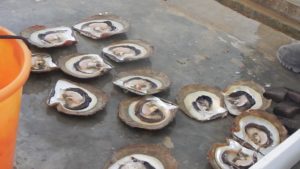South Sea Pearls in the Philippines
Hello Pearl Girls! I just arrived in China for my annual treasure hunt… and I am exhausted! Fortunately it is 10:30 at night so I have an excuse to go to bed. I will spend exactly one day here in China before heading off to the Philippines to tour South Sea pearl farms (and yes, I will shoot a video!) but I thought y’all might first want some info on the South Sea pearls of the Philippines.
The Philippines is a small producer of the gorgeous and enviable South Sea cultured pearls. South Sea pearls are large, averaging 10 to 13mm in diameter, and range in color from silvery grey to golden yellow. The pearl’s color depends on which type of mollusk produces it: the Gold Lipped or Silver Lipped oyster. The Philippines contributes to 15% of the world’s supply of South Sea pearls.

It’s a Tough Business
There are exactly 23 pearl companies in the Philippines today. 19 of these companies are locally owned and the remaining 4 are owned by international companies.
The Philippines is a perfect example of how difficult it is to establish a pearl farming business. There have been attempts at establishing successful pearl farms in the Philippines since the early 1900s but it really took 70 years for modern day farms to get established. The Philippines government is very supportive of pearl farming but they also fight hard to regulate this industry.
Compared to the large-scale production in Australia (which is the largest supplier of the world’s South Sea Pearls), the pearl farming techniques of the Philippines might seem primitive to some.
90% of the oysters used to produce South Sea Pearls in the Philippines are born in hatcheries, but the pearl farming industry actually began with mollusks that world famous divers found in the sea. On average after one day of diving, they would yield 3-5 mollusks. So, as you can imagine, the process was extremely time consuming and eventually led to depletion of local mollusk populations in the wild.
The Life Journey of a South Sea Pearl
Now, hatcheries are used to breed and grow the mollusks, which are then nucleated at some point between 18 and 30 months in age. Nucleation is a delicate process in which a farmer inserts a round pearl shell in the gonad of the oyster. After nucleation, the pearl grows for 18 to 30 more months until a farmer extracts it. The pearl farmers may nucleate the oysters again, up to 3 times.
The Philippines is an island nation and there are more islands than most people imagine…over 7,000 in fact! But out of all those islands and waterways, it is difficult to find good pearl farming sites. What does it take to start a pearl farm? First and foremost, good clean water. So, the ideal location for a pearl farm is far away from areas of high population with potentially polluted water. Additionally, typhoons and changes in water temperatures can pose a risk to the growing mollusks, so sites must be well protected. Finally, the mollusks need well-oxygenated water and a supply of fresh plankton. This means the best sites are small channels between remote islands where the water flow is good. These remote areas add to total production costs. Pearl farmers research their farming sites by using nautical maps, charts and by scouting areas by airplane.

Pearls & the Government
The Philippine government is supportive of pearl farmers, and they have named the South Sea pearl the national gem of the Philippines. They are also very conscious of the impact of pearl farms on the environment and local fishermen. The government requires feasibility studies before a prospective pearl farmer can establish a new farm. The farmers must prove that they have both expertise and guaranteed capital. A pearl farm can take up to ten years to become profitable, so farmers must be prepared to bear the cost of establishing their farms at the beginning.
For a farm to be a success, half of all of the mollusks it nucleates must produce a marketable pearl. The nicer the pearls a farm is able to produce, the more successful it will become. Most of the farms that produce South Sea pearls in the Philippines sell them to wholesale and retail buyers who travel here.
At The Pearl Girls, we have a lovely South Sea single pearl necklace! It’s one of our most popular necklaces. Check out our website for your pearl jewelry needs! We have everything from earrings and necklaces to bracelets and even rings!
P.S. – If you’re interested in reading about more traveling adventures (Mexico, Japan, Fiji, French Polynesia…and more!), check out the Pearl Travel page!
I am a modern day treasure hunter who travels the world for gorgeous pearls and amazing adventures. I own a pearl jewelry and jewelry repair business, ThePearlGirls.com, with a cute retail store in Athens, GA. I also have a Pearl Travel business and travel blog at TheWorldofPearl.com.


